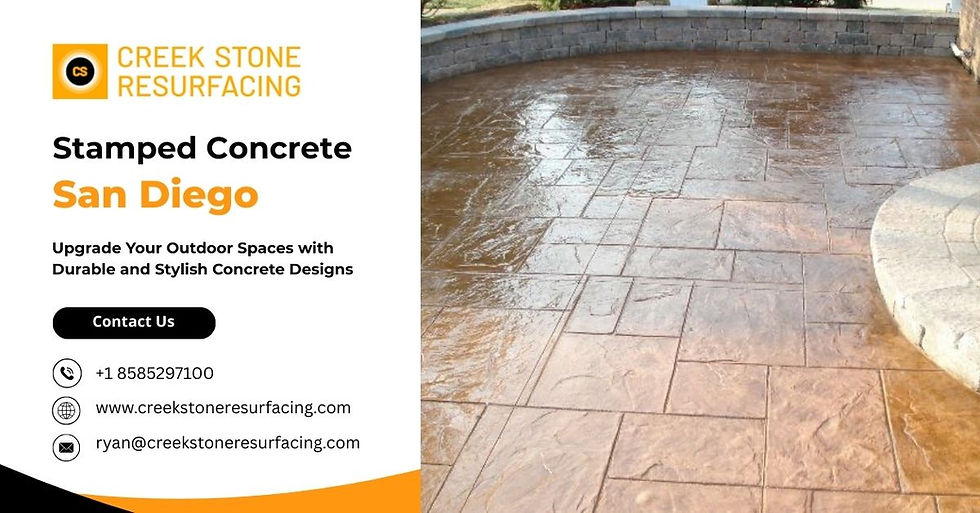Durable and Stylish Pool Deck Resurfacing Options
- james85611
- Sep 16, 2024
- 4 min read

A pool deck is more than just a space surrounding your swimming pool. It is where you relax, hosts poolside gatherings, and enjoy the sunshine. However, over time, exposure to water, sun, and wear and tear can cause your pool deck to crack, fade, or become unsafe. That is where pool deck resurfacing comes in. Instead of replacing the entire deck, resurfacing is a cost-effective way to refresh its look and improve its durability.
If you are wondering what the best resurfacing options are, here is a simple guide to help you choose something durable and stylish.
Concrete Resurfacing
Concrete is one of the most popular choices for pool deck resurfacing. Not only is it durable, but it is also incredibly versatile. Concrete can be customized to mimic other materials like stone, brick, or even wood, giving you plenty of design options. The resurfacing process typically involves applying a thin overlay of concrete that can be stamped, colored, or textured according to your preference.
One great benefit of concrete is its slip-resistant finish. This is especially important for safety around the pool area. You can add a textured surface to reduce the chances of slipping while still keeping the deck comfortable underfoot.
Pros:
Highly durable
Affordable
Customizable designs and finishes
Slip-resistant
Cons:
It can crack over time if not properly maintained.
Paver Overlay
If you want something visually striking, pavers are an excellent option for pool deck resurfacing. Pavers come in various colors, shapes, and textures, allowing you to create unique patterns that can give your pool area a custom look. The great thing about pavers is that they are easy to replace if one gets damaged. You don’t have to resurface the whole deck—just swap out the damaged paver.
Pavers also provide a naturally slip-resistant surface, and they don't get as hot in the sun as concrete, which is a big plus on hot summer days. They are also durable, so they will last for years with proper care.
Pros:
Aesthetic variety with custom patterns
Slip-resistant and cooler underfoot
Easy to replace individual pavers
Cons:
Can be more expensive than other options
Weeds may grow between pavers if not properly sealed
Spray-Deck Resurfacing
Spray-deck, also known as spray texture, is a popular option for pool deck resurfacing because of its durability and affordability. This material is sprayed onto the deck and then textured to create a slip-resistant surface. It is available in various colors and designs, allowing you to match the deck with your pool and outdoor area.
Spray-deck also reflects heat better than some other resurfacing materials, making it cooler to walk on during hot days. It is low-maintenance and holds up well in harsh weather conditions.
Pros:
Affordable
Slip-resistant
Stays cooler underfoot
Available in many colors and designs
Cons:
May fade over time with constant sun exposure
Can require occasional re-sealing

Stamped Concrete
Stamped concrete is another fantastic pool deck resurfacing option that combines both beauty and durability. It is similar to regular concrete resurfacing but with a twist: the concrete is stamped to create textures that mimic high-end materials like stone, slate, or even brick. You get the luxurious look of these materials without the high price tag.
In addition to its stylish appearance, stamped concrete can be colored and sealed to protect it from wear and tear. It is also slip-resistant when properly sealed, making it a safe option for pool areas.
Pros:
Looks like high-end materials
Customizable designs and colors
Affordable compared to natural stone
Cons:
Can crack if not maintained
Requires sealing every few years
Tile Resurfacing
If you want a truly elegant look for your pool deck, tile resurfacing is a great option. Pool deck tiles come in various styles, including porcelain, stone, or even mosaics. Tiles can transform your pool deck into a luxurious outdoor space that feels like a resort.
While tiles are incredibly stylish, it is important to choose slip-resistant varieties for safety. The downside is that tile resurfacing can be more expensive than other options, and they can crack or chip if exposed to freezing temperatures.
Pros:
Luxurious and high-end look
Variety of styles and colors
Durable and easy to clean
Cons:
More expensive than other resurfacing options
Can crack in freezing weather
Wood Deck Overlay
If you love the natural look of wood, you can opt for a wood deck overlay for pool deck resurfacing. Wood decks add warmth and charm to outdoor areas. However, it is important to choose a wood that is treated for outdoor use and water resistant, such as cedar or teak.
While wood is beautiful, it requires regular maintenance, such as sealing and staining, to keep it from warping or rotting. A wood deck also needs more frequent cleaning to prevent mold or mildew.
Pros:
The natural, warm look
Customizable with different wood types and stains
Cons:
Requires more maintenance
Not as slip-resistant as other materials
Conclusion
When it comes to pool deck resurfacing, the right option depends on your budget, style preference, and the maintenance level you are willing to commit to. Whether you choose the affordability and durability of concrete, the high-end look of stamped concrete, or the charm of wood, resurfacing your pool deck can dramatically improve both its appearance and functionality.
Do not wait until your pool deck becomes unsafe or unsightly—give it a fresh new look with one of these resurfacing options. Your poolside days will feel even more enjoyable once your deck is looking its best!
If you are looking for pool deck resurfacing contractors in San Diego and surroundings area then contact Creek Stone Resurfacing.



Comments